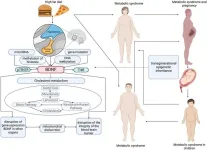New journal Cell Organoid launched to propel advancements in organoid technology
2024-07-30
(Press-News.org)
Organoid technology began with Professor Hans Clevers' 2009 breakthrough in cultivating the first intestinal organoid from mice. Since then, the field has expanded exponentially, showcasing organoids' remarkable capabilities in replicating human organ physiology and pathology. Organoids, which are three-dimensional stem cell cultures, offer powerful tools for studying organ development, modeling diseases, and facilitating drug discovery. Their ability to maintain genetic diversity and mimic complex biological processes makes them invaluable in biomedical research.
Published by Tsinghua University Press, Cell Organoid brings together leading experts from diverse fields, including developmental biology, stem cell research, tissue engineering, and computational biology. The journal’s editorial board comprises renowned scientists dedicated to advancing organoid research. The journal aims to provide a comprehensive overview of current trends and future directions in this rapidly evolving field.
Organoids replicate human organs' physiology and pathology, playing a crucial role in understanding developmental mechanisms, identifying therapeutic targets, and advancing organ transplantation research. Despite significant advancements, the field faces challenges such as standardizing methodologies, developing appropriate biomaterials, and creating vascular systems for nutrient supply and waste removal. Additionally, ethical considerations arise, particularly with human brain organoids, which present complex questions about moral status and research implications. Addressing these challenges requires interdisciplinary approaches and innovative techniques like organ-on-chip optimization.
Cell Organoid is headed up by an academic Editor-in-Chief, Prof. Chen-Zhong Li, and an Executive Editor-in-Chief, Dr. Libra Lou. They emphasize that Cell Organoid will serve as a central hub for high-quality research, fostering innovation and collaboration across disciplines. The journal’s mission is to push the boundaries of knowledge while maintaining the highest standards of scientific rigor and research integrity. Through rigorous peer review and editorial oversight, Cell Organoid aims to ensure that each publication represents a valuable contribution to the field of organoid research. The journal seeks to catalyze scientific discovery, promote interdisciplinary collaboration, and accelerate the translation of research findings into clinical applications.
Cell Organoid aims to profoundly impact the biomedical field by bridging the gap between basic research and clinical applications. By addressing ethical, technical, and standardization challenges, the journal aspires to advance personalized medicine and therapeutic interventions. The potential of organoid technology to enhance our understanding of human health and disease is immense, and Cell Organoid is poised to play a crucial role in this scientific revolution. Researchers, clinicians, and students are invited to contribute, review, and engage with this new journal, driving forward the exploration of organoids and opening new vistas of understanding and possibility.
About Cell Organoid
Cell Organoid aims to provide a worldwide platform for research into all aspects of organoids and their applications in medicine. It is an open access, peer-reviewed journal that publishes high-quality articles dealing with a wide range of basic research, clinical and translational medicine study topics in the field.
Journal website: https://www.sciopen.com/journal/3007-6552
Submission site: https://mc03.manuscriptcentral.com/cellorganoid
About SciOpen
SciOpen is an open access resource of scientific and technical content published by Tsinghua University Press and its publishing partners. SciOpen provides end-to-end services across manuscript submission, peer review, content hosting, analytics, identity management, and expert advice to ensure each journal’s development. By digitalizing the publishing process, SciOpen widens the reach, deepens the impact, and accelerates the exchange of ideas.
END
[Attachments] See images for this press release:

ELSE PRESS RELEASES FROM THIS DATE:
2024-07-30
WASHINGTON—The Endocrine Society, the world’s oldest and largest organization of scientists devoted to hormone research and physicians who care for people with hormone-related conditions, announced it is merging with the Association of Program Directors in Endocrinology, Diabetes and Metabolism (APDEM).
APDEM represents the academic leaders of more than 135 training programs that prepare fellows for clinical and research careers in endocrinology and metabolism.
“The Endocrine Society and APDEM share a commitment to ...
2024-07-30
(Toronto, July 30, 2024) JMIR Publications, a leading publisher in digital health research, announces the launch of JMIR XR and Spatial Computing, a cutting-edge journal dedicated to exploring the transformative potential of extended reality (XR) and spatial computing technologies in clinical practice.
This new journal arrives at a pivotal moment when recent advancements in artificial intelligence (AI), graphical processing, display technology, and network connectivity are propelling XR and spatial ...
2024-07-30
Metabolic syndrome (MetS) is a multifaceted disorder that impacts approximately 20–25% of the global population. This syndrome encompasses a range of conditions, including obesity, type 2 diabetes mellitus, hyperinsulinemia, insulin resistance (IR), hypercholesterolemia, nonalcoholic fatty liver disease, nonalcoholic steatohepatitis, and systemic metabolic inflammation. These conditions collectively lead to severe diseases and increased premature mortality. The hypothalamus, a critical brain structure regulating ...
2024-07-30
SAN ANTONIO — July 30, 2024 — Dr. James Oxley, an Institute scientist at Southwest Research Institute’s Chemistry and Chemical Engineering Division, has been named a Fellow by the Controlled Release Society. Recognized for excellence and innovation in delivery science, Oxley is an expert in microencapsulation, nanoencapsulation and other controlled-release technologies used in energy, food, pharmaceutical, cosmetic and consumer product applications.
“I’m honored and humbled by this recognition,” said Oxley, who began his Institute career in 2004. “Encapsulation research ...
2024-07-30
University of Virginia School of Medicine researchers have identified a potential treatment for the respiratory symptoms of long COVID after discovering an unknown cause of the condition inside the lungs.
The UVA researchers, led by Jie Sun, PhD, found that COVID-19 infection can cause sweeping changes in immune cells inside the lung tissues, promoting scarring and driving ongoing inflammation even after the initial infection has passed. This ongoing inflammation, they believe, drives the lasting respiratory symptoms, such as cough and difficulty breathing, associated with long COVID.
The new research from Sun and ...
2024-07-30
BEER-SHEVA, Israel, July 30, 2024 – Antibiotic resistant bacterial pathogens are on the rise, while fewer antibiotics are being developed. Prof. Ariel Kushmaro and his local and international colleagues tackled the need by focusing on the long pepper. Known in traditional medicine for its treatment of a variety of illnesses, the team created a derivative that disrupts bacterial chemical communication.
Their findings were just published in Biofilm (https://doi.org/10.1016/j.bioflm.2024.100215).
Many plants' secondary metabolites are essential ...
2024-07-30
By Benjamin Boettner
(BOSTON) — Since the 1950s, researchers have used a famous method invented by Wallace Coulter known as “flow cytometry” to characterize different types of immune cells in research studies and in blood samples from human individuals. This has enabled a much deeper understanding of immune cell development as well as new ways to assess human health and diagnose various blood cancers. Later, flow cytometry was applied also to other cell types.
In traditional flow cytometry, cell surface and intracellular proteins are detected with antibody molecules that are linked to fluorescent probes. However, while providing single-cell ...
2024-07-30
Not all police misconduct is the same. Misconduct can range from offenses like homicide and sexual assault to seemingly minor infractions such as accepting free coffee from the public. Exactly what qualifies as police misconduct varies locally, and the response to this behavior is typically handled internally by law enforcement.
The absence of a commonly accepted framework to assess and interpret police misconduct remains a complex and contentious issue. Moreover, progress in researching this area is hindered by the limited ...
2024-07-30
Genetically engineered human skin bacteria can make mice less attractive to mosquitoes for 11 days. Mosquitoes transmit a host of deadly diseases, including malaria, West Nile, dengue, yellow fever, and Zika. Female mosquitoes on the hunt for a blood meal tune into scents released by skin microbes that live on their targets. Omar Akbari and colleagues engineered versions of the common human skin commensals Staphylococcus epidermidis and Corynebacterium amycolatum to produce much less of a form of lactic acid known to attract mosquitoes. The authors tested the microbes alone and found the engineered version of S. epidermidis attracted about half as ...
2024-07-30
The liver's ability to communicate with other organs is crucial for maintaining homeostasis, particularly through signaling pathways. During liver regeneration, communication with organs such as the brain, pancreas, intestine, and heart is vital, mediated by chemical messengers like hormones, cytokines, and growth factors. Among these signals, the TGF-β and HIPPO pathways are critical, functioning as tumor suppressors and regulating liver development and regeneration. The review focuses on these pathways' interplay in maintaining liver homeostasis, facilitating regeneration, and contributing to diseases like hepatitis, fibrosis, ...
LAST 30 PRESS RELEASES:
[Press-News.org] New journal Cell Organoid launched to propel advancements in organoid technology







